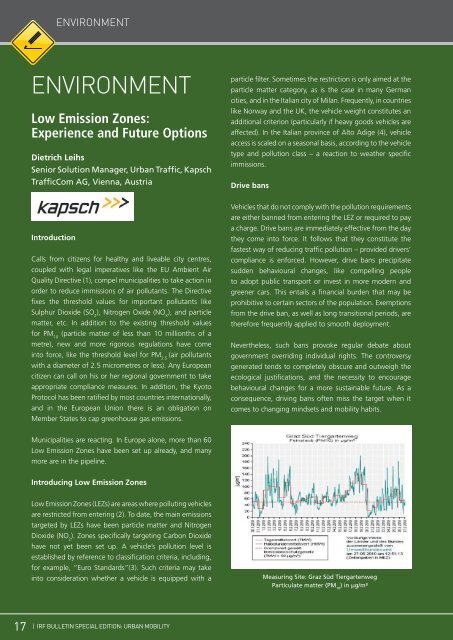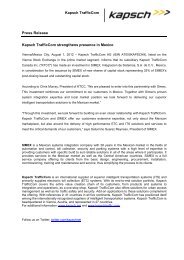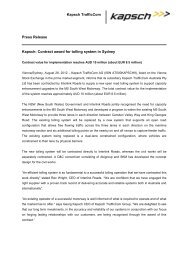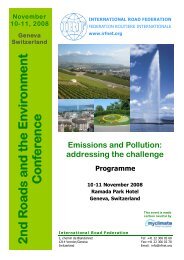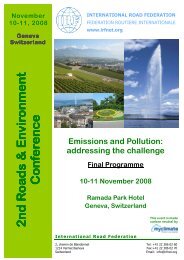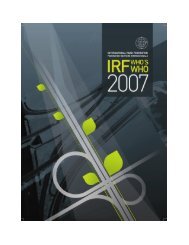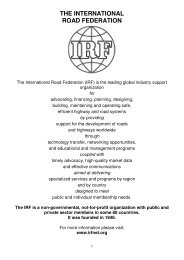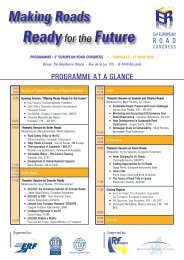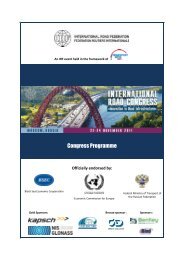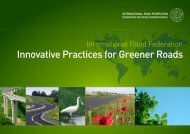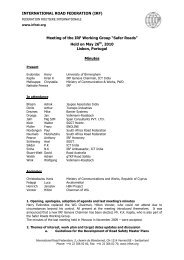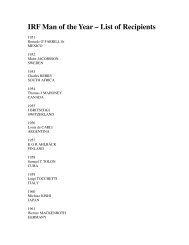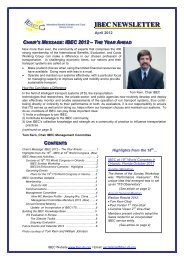Motorways and Urban Mobility - International Road Federation
Motorways and Urban Mobility - International Road Federation
Motorways and Urban Mobility - International Road Federation
Create successful ePaper yourself
Turn your PDF publications into a flip-book with our unique Google optimized e-Paper software.
17<br />
ENVIRONMENT<br />
Low Emission Zones:<br />
Experience <strong>and</strong> Future Options<br />
Dietrich Leihs<br />
Senior Solution Manager, <strong>Urban</strong> Traffic, Kapsch<br />
TrafficCom AG, Vienna, Austria<br />
Introduction<br />
ENVIRONMENT<br />
Calls from citizens for healthy <strong>and</strong> liveable city centres,<br />
coupled with legal imperatives like the EU Ambient Air<br />
Quality Directive (1), compel municipalities to take action in<br />
order to reduce immissions of air pollutants. The Directive<br />
fixes the threshold values for important pollutants like<br />
Sulphur Dioxide (SO ), Nitrogen Oxide (NO ), <strong>and</strong> particle<br />
2 X<br />
matter, etc. In addition to the existing threshold values<br />
for PM (particle matter of less than 10 millionths of a<br />
10<br />
metre), new <strong>and</strong> more rigorous regulations have come<br />
into force, like the threshold level for PM (air pollutants<br />
2.5<br />
with a diameter of 2.5 micrometres or less). Any European<br />
citizen can call on his or her regional government to take<br />
appropriate compliance measures. In addition, the Kyoto<br />
Protocol has been ratified by most countries internationally,<br />
<strong>and</strong> in the European Union there is an obligation on<br />
Member States to cap greenhouse gas emissions.<br />
Municipalities are reacting. In Europe alone, more than 60<br />
Low Emission Zones have been set up already, <strong>and</strong> many<br />
more are in the pipeline.<br />
Introducing Low Emission Zones<br />
Low Emission Zones (LEZs) are areas where polluting vehicles<br />
are restricted from entering (2). To date, the main emissions<br />
targeted by LEZs have been particle matter <strong>and</strong> Nitrogen<br />
Dioxide (NO ). Zones specifically targeting Carbon Dioxide<br />
2<br />
have not yet been set up. A vehicle’s pollution level is<br />
established by reference to classification criteria, including,<br />
for example, “Euro St<strong>and</strong>ards”(3). Such criteria may take<br />
into consideration whether a vehicle is equipped with a<br />
| IRF BULLETIN SPECIAL EDITION: URBAN MOBILITY<br />
particle filter. Sometimes the restriction is only aimed at the<br />
particle matter category, as is the case in many German<br />
cities, <strong>and</strong> in the Italian city of Milan. Frequently, in countries<br />
like Norway <strong>and</strong> the UK, the vehicle weight constitutes an<br />
additional criterion (particularly if heavy goods vehicles are<br />
affected). In the Italian province of Alto Adige (4), vehicle<br />
access is scaled on a seasonal basis, according to the vehicle<br />
type <strong>and</strong> pollution class – a reaction to weather specific<br />
immissions.<br />
Drive bans<br />
Vehicles that do not comply with the pollution requirements<br />
are either banned from entering the LEZ or required to pay<br />
a charge. Drive bans are immediately effective from the day<br />
they come into force. It follows that they constitute the<br />
fastest way of reducing traffic pollution – provided drivers’<br />
compliance is enforced. However, drive bans precipitate<br />
sudden behavioural changes, like compelling people<br />
to adopt public transport or invest in more modern <strong>and</strong><br />
greener cars. This entails a financial burden that may be<br />
prohibitive to certain sectors of the population. Exemptions<br />
from the drive ban, as well as long transitional periods, are<br />
therefore frequently applied to smooth deployment.<br />
Nevertheless, such bans provoke regular debate about<br />
government overriding individual rights. The controversy<br />
generated tends to completely obscure <strong>and</strong> outweigh the<br />
ecological justifications, <strong>and</strong> the necessity to encourage<br />
behavioural changes for a more sustainable future. As a<br />
consequence, driving bans often miss the target when it<br />
comes to changing mindsets <strong>and</strong> mobility habits.<br />
Measuring Site: Graz Süd Tiergartenweg<br />
Particulate matter (PM 10 ) in µg/m³


